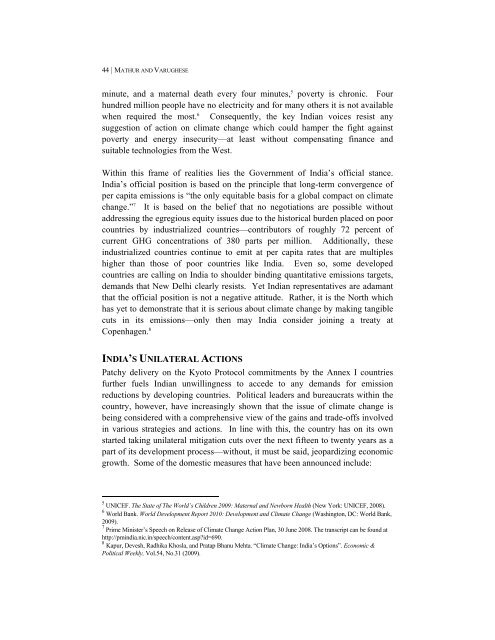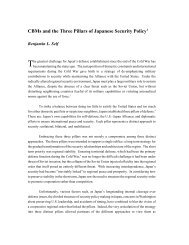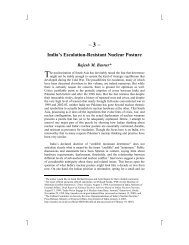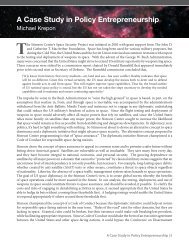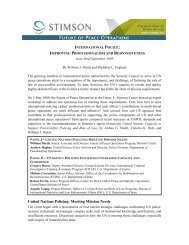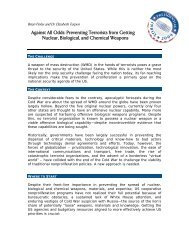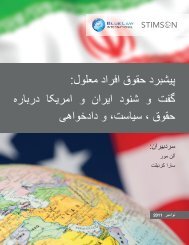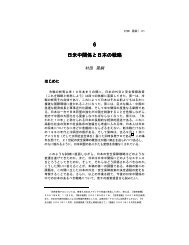Indian Climate Policy: Choices and Challenges - The Stimson Center
Indian Climate Policy: Choices and Challenges - The Stimson Center
Indian Climate Policy: Choices and Challenges - The Stimson Center
You also want an ePaper? Increase the reach of your titles
YUMPU automatically turns print PDFs into web optimized ePapers that Google loves.
44 | MATHUR AND VARUGHESE<br />
minute, <strong>and</strong> a maternal death every four minutes, 5 poverty is chronic. Four<br />
hundred million people have no electricity <strong>and</strong> for many others it is not available<br />
when required the most. 6 Consequently, the key <strong>Indian</strong> voices resist any<br />
suggestion of action on climate change which could hamper the fight against<br />
poverty <strong>and</strong> energy insecurity—at least without compensating finance <strong>and</strong><br />
suitable technologies from the West.<br />
Within this frame of realities lies the Government of India’s official stance.<br />
India’s official position is based on the principle that long-term convergence of<br />
per capita emissions is “the only equitable basis for a global compact on climate<br />
change.” 7 It is based on the belief that no negotiations are possible without<br />
addressing the egregious equity issues due to the historical burden placed on poor<br />
countries by industrialized countries—contributors of roughly 72 percent of<br />
current GHG concentrations of 380 parts per million. Additionally, these<br />
industrialized countries continue to emit at per capita rates that are multiples<br />
higher than those of poor countries like India. Even so, some developed<br />
countries are calling on India to shoulder binding quantitative emissions targets,<br />
dem<strong>and</strong>s that New Delhi clearly resists. Yet <strong>Indian</strong> representatives are adamant<br />
that the official position is not a negative attitude. Rather, it is the North which<br />
has yet to demonstrate that it is serious about climate change by making tangible<br />
cuts in its emissions—only then may India consider joining a treaty at<br />
Copenhagen. 8<br />
INDIA’S UNILATERAL ACTIONS<br />
Patchy delivery on the Kyoto Protocol commitments by the Annex I countries<br />
further fuels <strong>Indian</strong> unwillingness to accede to any dem<strong>and</strong>s for emission<br />
reductions by developing countries. Political leaders <strong>and</strong> bureaucrats within the<br />
country, however, have increasingly shown that the issue of climate change is<br />
being considered with a comprehensive view of the gains <strong>and</strong> trade-offs involved<br />
in various strategies <strong>and</strong> actions. In line with this, the country has on its own<br />
started taking unilateral mitigation cuts over the next fifteen to twenty years as a<br />
part of its development process—without, it must be said, jeopardizing economic<br />
growth. Some of the domestic measures that have been announced include:<br />
5 UNICEF. <strong>The</strong> State of <strong>The</strong> World’s Children 2009: Maternal <strong>and</strong> Newborn Health (New York: UNICEF, 2008).<br />
6 World Bank. World Development Report 2010: Development <strong>and</strong> <strong>Climate</strong> Change (Washington, DC: World Bank,<br />
2009).<br />
7 Prime Minister’s Speech on Release of <strong>Climate</strong> Change Action Plan, 30 June 2008. <strong>The</strong> transcript can be found at<br />
http://pmindia.nic.in/speech/content.asp?id=690.<br />
8 Kapur, Devesh, Radhika Khosla, <strong>and</strong> Pratap Bhanu Mehta. “<strong>Climate</strong> Change: India’s Options”. Economic &<br />
Political Weekly, Vol.54, No.31 (2009).


